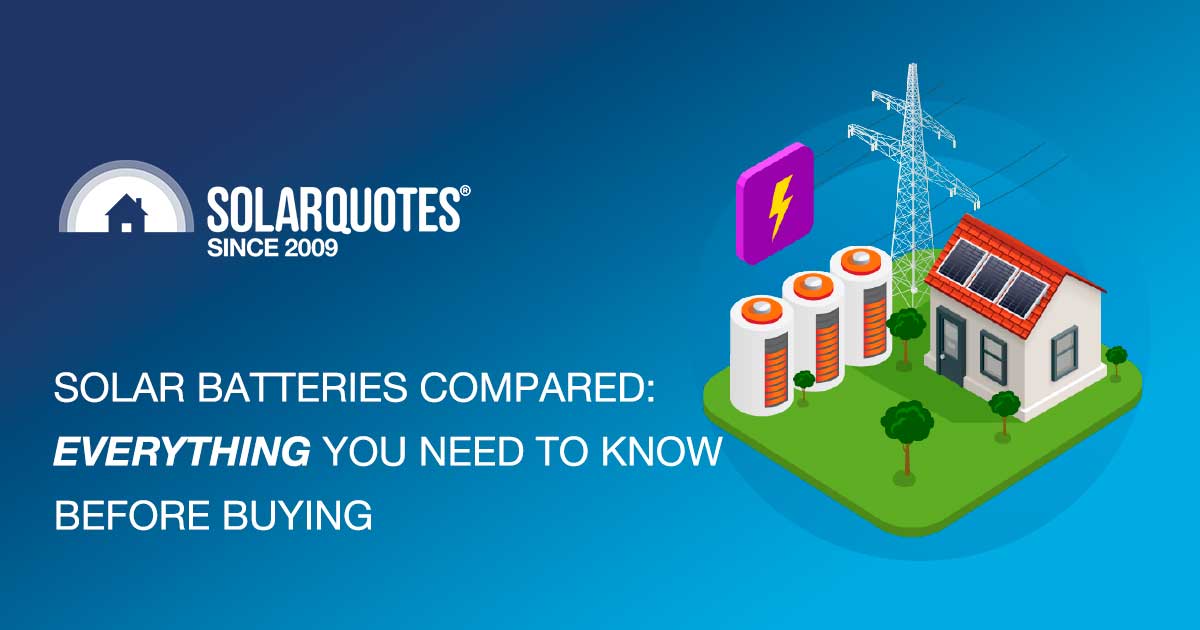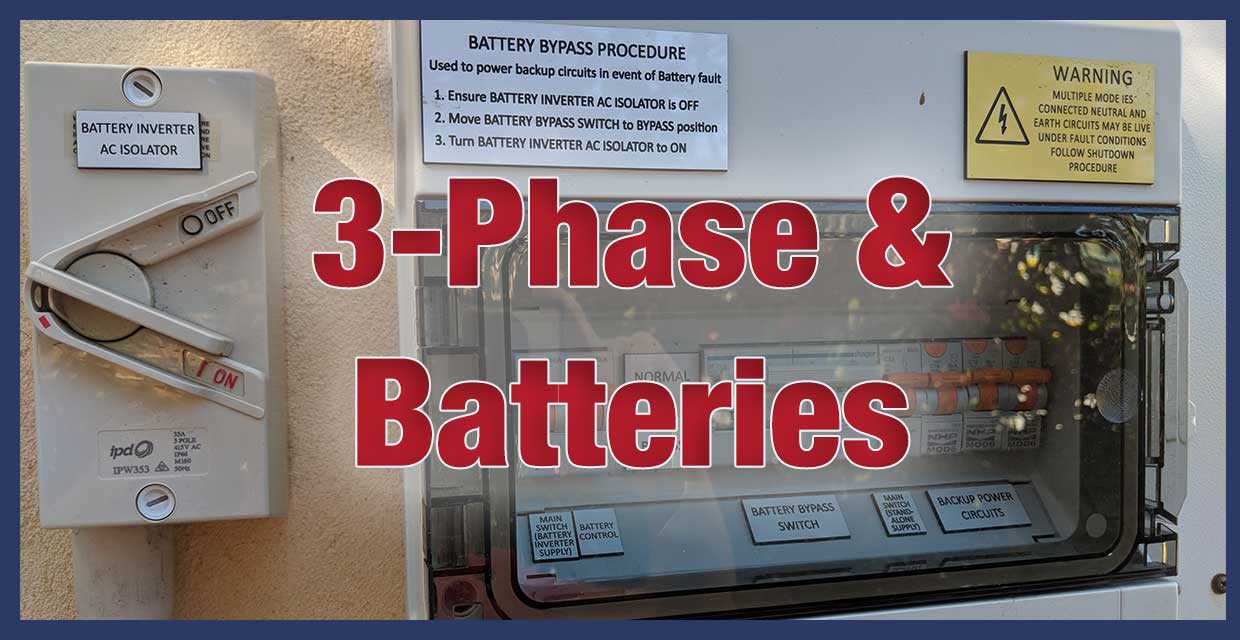Welcome to Tesla Motors Club
Discuss Tesla's Model S, Model 3, Model X, Model Y, Cybertruck, Roadster and More.
Register
Install the app
How to install the app on iOS
You can install our site as a web app on your iOS device by utilizing the Add to Home Screen feature in Safari. Please see this thread for more details on this.
Note: This feature may not be available in some browsers.
-
Want to remove ads? Register an account and login to see fewer ads, and become a Supporting Member to remove almost all ads.
You are using an out of date browser. It may not display this or other websites correctly.
You should upgrade or use an alternative browser.
You should upgrade or use an alternative browser.
Ausgrid changing pricing for electricity grid access
- Thread starter Quickst
- Start date
3 x Powerwall 2?..Whats a good 3phase AC coupled battery 15kW/50kWh?
Enphase make 3 phase batteries. Not sure about the power and capacity.Whats a good 3phase AC coupled battery 15kW/50kWh?
Batteries currently available in Australia...

 www.solarquotes.com.au
www.solarquotes.com.au
Some other light reading...

 www.solarquotes.com.au
www.solarquotes.com.au
Enphase are very expensive, around $9K per 5kWh from my recent search.
Here's an interesting option but no real presence in Australia yet.
 www.sigenergy.com
www.sigenergy.com

Solar Batteries: Everything You Need To Know (Prices, Paybacks, Brands)
If you are considering a solar battery, my comprehensive guide walks you through brands, prices, payback, installation and much more...
Some other light reading...

Don't Add Batteries To A 3-Phase Home Before Reading This
If you have a 3 phase home and want to add solar batteries, you need to be really careful. If your installer chooses the wrong design your bill savings will be crippled and your backup ineffective. Here's what you need to know to get it right.
Enphase are very expensive, around $9K per 5kWh from my recent search.
Here's an interesting option but no real presence in Australia yet.
Residential ESS | Commercial Solar Solution | Sigenergy
Harness the residential ESS and commercial solar solution for sustainable living. Go green with Sigenergy by using our solar energy system for home. Quote us!
If Amber fully pass this on it would just mean your feed-in value between 10am to 3pm would be 1.2c/kWh lower than otherwise towards the end of the month after you pass the 10am-3pm export threshold. Obviously would need some software work on their end, but after that it's just one more factor in the variable pricing mix as far as the consumer is concerned.Am I correct in thinking that Amber supplies software that helps manage this sort of stuff if you are with them?
Am I correct in thinking that Amber supplies software that helps manage this sort of stuff if you are with them?
Yes, Amber manage everything if you are part of their VPP. I figure their algorithms are going to be ten times smarter than anything I could come up with, so I happily gave them control of my battery.
Amber provide some ability to manually override their control, but frankly, I can’t imagine many situations where I would want to do that. Just let them do their SmartShift thing and sit back and do nothing. It all happens automatically.
Until 1 July, Amber put me on the “special” Ausgrid two-way tariff trial, where I get paid a bonus 26.6c/kWh for solar export on top of the normal wholesale export price. Ka-Ching!
Ta, might be needing to move from Powershop to Amber soon
See the Amber thread
Is there a way to turn off grid exports for particular times of the day? Some sort of “smart” inverter or controller?
Amber will do automatic solar curtailment if/when export prices go negative if you have a compatible Inverter. SolarEdge for example is compatible. It means solar export will be throttled to zero but your house can still take advantage of your own solar.
Only works if the customer is generally a low kWh exporter/importerAmber
I told them I export about 25,000kwh /year and they immediately said they can't
As my system is more or less fully amortised, It matters little to me if I disconnect one or more panels.
Batteries are nearly there...The BYD battery box looks very interesting. Not a lot of detail though
Last edited:
Time to buy the second battery?
Well the economics of house batteries are pretty ropey to begin with (>10 year payback) and a second battery will be even worse (>20 years) however the advent of VPPs will change that if you get paid healthy amounts for being able to export power at the right time.
Clearly at a grid scale it is very lucrative hence the explosion (pardon the term) in 4- and 8-hour grid batteries being built here now in record time. So a second house battery might make financial sense if you planned to aggressively use it as part of a VPP and hence handed complete control of it over to the VPP and don’t expect to use any of that power yourself.
It’s tricky to run the numbers as I’ve only just started this journey so I don’t know how much power my battery will end up exporting per month or year and at what price, but conceivably it could shrink the payback time below 10 years.
doggy1
Member
I imagine you have to keep an eye on your Powerwall cycles to ensure you do not hit the warranty-limit prior to the time based warranty expiring?It’s tricky to run the numbers as I’ve only just started this journey so I don’t know how much power my battery will end up exporting per month or year and at what price, but conceivably it could shrink the payback time below 10 years.
I imagine you have to keep an eye on your Powerwall cycles to ensure you do not hit the warranty-limit prior to the time based warranty expiring?
I did check that out before signing up… if you are part of a VPP then the warranty limit is 37 MWh throughput measured at the AC output. Guesswork isn’t required because this figure is reported by the PW2’s own API. Mine is currently at 13.9 MWh discharged, and I’m exactly 5 years in.
I don’t think it would be possible to cycle the battery enough times to trigger the 37 MWh limit before I lose 30% capacity anyway (I am down to 72%). I’m expecting to hit the warranty trigger next year - and will report here what my experience is
doggy1
Member
Interesting. So you've notched up somewhat over 1,200 cycles, which is not bad for NMC chemistry. So maybe the 70% SOH will be reached around 1,500 cycles. Presumably PW3s with LFP will have a longer battery life......expecting to hit the warranty trigger next year
If my car manages that many cycles, it would be about 750,000kms. However car batteries are likely to be worked harder in terms of heavier charge/discharge currents.
Interesting. So you've notched up somewhat over 1,200 cycles, which is not bad for NMC chemistry.
It’s OK, but my understanding is my PW2 degradation is not “normal” and somewhat of an outlier. As to why that is,
Agree about the second one, disagree about the first one. We have house running on electricity only and the peak price is 65c/kWh, yes, SA. Mine will pay back in 4-5 years + convenience. Note that it is not only 12.5kWh for night, it removes the external consumption completely during the day because the power variation from the panels does not force me to suck from the grid, because the battery kicks in and then recharges. In total we push through the powerwall about 16kWh in one day, which makes it a little less than 4 years at 65c/kWh with 15k for battery+installation.Well the economics of house batteries are pretty ropey to begin with (>10 year payback) and a second battery will be even worse (>20 years)
The second one is much harder to justify economically now, but if our electrons will be declared wrong religion/dark colour/etc electrons and we will need to pay for exporting them to the grid, it may get much easier. For example, if I will be paying 65c/kWh for import and 10c/kWh for export, it will be only 6 years payback for two batteries, if I export about 40-50 kWh per day, assuming a good summer day repeats for 365 days a year. So... with this rip-off you never know.
Disagree. The other way round. It's not the charge or discharge currents. PW2 power rating is 5kW. Car batteries can be charged at up to 250kW but they are maybe circa only 5 times larger .car batteries are likely to be worked harder in terms of heavier charge/discharge currents
The main reason I think is that House batteries are discharged to a greater depth of discharge than car batteries. From 80-20% or 100-10 between charges (Don't know exactly as I don't have one). Very few cars fully discharge (drive 400-500) between charges once a day every day whereas house batteries do this perhaps not everyday but a lot more than car batteries.
Also charged to very high and very low SoC
Agree about the second one, disagree about the first one. We have house running on electricity only and the peak price is 65c/kWh, yes, SA. Mine will pay back in 4-5 years + convenience.
I calculated the payback time of my battery by itself, based on the value of the electricity it has discharged at the time it discharged it, less foregone FIT (I’ve kept all my PW2 5-minute data since installation).
Payback time is currently at 12.6 years. Increasing grid prices reduce the payback time, using it in a VPP to get paid to export when wholesale prices are through the roof would reduce it some more, but how much no idea yet.
If I look at my solar+battery as a whole and calculate a blended payback time it is 7.8 years.
Yes, and you probably have peak electricity for about 30c/kWh.I calculated the payback time of my battery by itself, based on the value of the electricity it has discharged at the time it discharged it, less foregone FIT (I’ve kept all my PW2 5-minute data since installation).
Payback time is currently at 12.6 years. Increasing grid prices reduce the payback time, using it in a VPP to get paid to export when wholesale prices are through the roof would reduce it some more, but how much no idea yet.
Yes, and you probably have peak electricity for about 30c/kWh.
My previous plan, before jumping to Amber a week ago, had peak electricity at 63c/kWh.
Interesting. What is your daily electricity consumption?My previous plan, before jumping to Amber a week ago, had peak electricity at 63c/kWh.
Interesting. What is your daily electricity consumption?
In the past 12 months, 33.5 kWh/day.
And how much of that goes through the powerwall?In the past 12 months, 33.5 kWh/day.
Similar threads
- Replies
- 5
- Views
- 260
- Replies
- 75
- Views
- 3K
- Replies
- 25
- Views
- 1K


